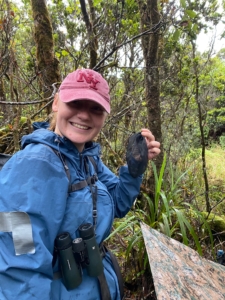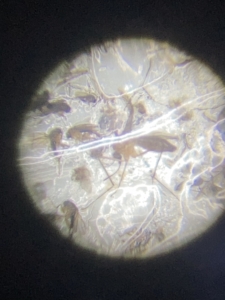On Emily and my first camping trip into the Alakaʻi, we went with Bow, one of the field assistants, to a remote site that had not recently been visited by KFBRP. The main objectives of the trip were to run mosquito traps, look for nest sites, and, as Justin likes to tell everyone, just have fun! There are two kinds of mosquito traps that are run overnight, one that catches mosquitoes that are looking for a food source, and one that catches mosquitoes that are looking to lay eggs, the first usually being much more successful in catching samples than the latter.
These traps are run to get a sense for how many mosquitoes are present in certain areas, as well as to collect samples to send to our partner labs on the mainland. The labs run both genetic and isotopic analysis on the mosquitoes to test for avian malaria, as well as get a sense for where the mosquitoes are hatching and how far they can travel. The two kinds of mosquitoes that we caught were the Culex and the Aedes. The Culex mosquitoes carry avian malaria, so we focused on taking those samples back to camp from the traps. On our first night running the traps at this site, we caught over 100 mosquitoes in the BG trap alone. Shortly before this trip, Bow and Kara, one of the other field assistants, had recently finished an intensive mosquito project running these traps all over the Alakaʻi. Bow told us that he had never caught this many mosquitoes in one night, so it was sad to see how successful our traps had been.
Avian malaria is the top threat to the forest birds on Kauaʻi, with climate change making more and more of the island available as breeding grounds to mosquitoes. Once bitten and infected, most native forest bird species stand little to no chance of surviving avian malaria. KFBRP is doing what they can to locally control some mosquito populations, however there is only so much a small organization can do. As mosquito populations spread to more of the island, there becomes less safe environment for the native birds to survive. Even when we were staying at Halepaʻakai, KFBRP’s most remote site, which is supposed to be ideal habitat for the birds, we were still being bitten by mosquitoes every night.
During our service with KFBRP, Chris, Emily and I had the opportunity to spend time with these birds and see them in their natural environment. Now that our time with KFBRP is coming to an end, the best thing we can do is take little steps everyday to reduce our carbon footprint and be environmentally conscious.




 Mitch Walters
Mitch Walters